How to insulate a gas cylinder outdoors in winter: the best insulation methods
Bottled gas is classified as a “dacha” option for fuel supply and is used where it is not possible to connect to the gas main.If one cylinder with propane-butane is enough for the stove, then to service the boiler you have to connect several.
Using tanks filled with liquefied gas is simple, but in winter problems can arise - the gas freezes or falls out as condensation. As a result, the stove or boiler stops functioning. Let's figure out how to insulate a gas cylinder outdoors in winter so that the fuel supply to the house is stable.
The content of the article:
Rules for installing gas cylinders
The need to heat gas cylinders arises when low outside temperatures cool them, thereby slowing down gas production. As a result, the working volume of fuel decreases, it is necessary to produce more often refueling.
In addition, there is a risk condensation, which also makes it difficult for gas to flow to burners - for example, to a stove or boiler.

The metal walls of the cabinet protect the cylinders from mechanical damage, wind and moisture, but do not heat them. The air temperature inside the casing is equal to the outside temperature. The cold is transferred to the body of the tanks and cools the fuel, which is in a liquid state.At low temperatures, the transition to the gaseous state becomes more difficult, condensation occurs, and the properties of the fuel change.
The most negative consequence of the cold is stopping the supply of fuel to the house, which can block all economic activity.
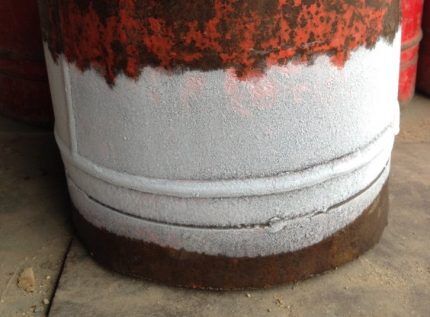
To refill cylinders, two components are used - butane and propane. They differ in characteristics: liquefied butane loses its properties at subzero temperatures, while propane, on the contrary, does not work in hot weather.
By combining the components in standard proportions, an optimally suitable mixture is obtained for use in the climatic conditions of a particular region. For more information about the proportions of different types of gas in the mixture, see GOST 20448-90.
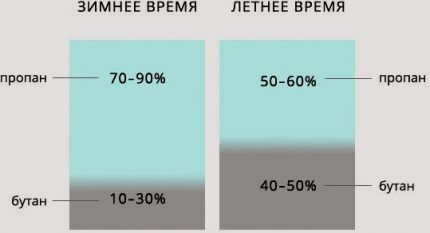
The regulatory documentation says nothing about cylinder insulation technologies. For example, in SNiP 31-02 – the main document on the gas supply of a country house – sets out the requirements only for the installation of fuel sources, there is no information about thermal insulation. This is why gas service workers recommend not insulating cylinders.
Methods for insulating cylinders outdoors
To save gas mixtures In working condition, cylinders are insulated in all possible ways. Some are effective, others are useless, and others can be life-threatening.
Let's find out what is the best way to insulate a gas cylinder outdoors in winter so that there are no problems with the fuel supply, and residents do not have to worry about their own health.
Method #1 – thermal insulation materials
Despite the prohibitions of gas service employees, owners of private houses often “envelop” cylinders with all kinds of insulation: mineral wool and glass wool, sheets of polystyrene foam and foam rubber - that is, household insulation materials that are actively used in building houses, erecting roofs, and laying floors.
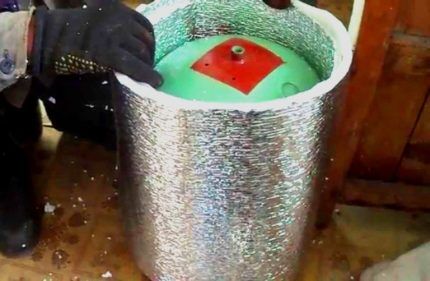
In fact, wrapping containers with insulation is a frankly primitive and ineffective way to warm gas in cylinders.
Why doesn't this method work? The fact is that thermal insulation “blankets” are good if the object produces heat on its own.
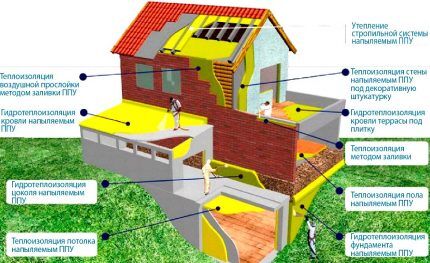
Gas cylinders do not generate any heat, therefore, even wrapped in three layers of mineral wool or polystyrene foam, they remain just as cold. Accordingly, the liquefied fuel inside does not change its characteristics - that is, no positive changes occur.
Conclusion: if a gas cylinder does not generate heat on its own, this function should be performed by a conditional “insulation” - a device that receives electrical power.
Let's move on to thermal insulation technologies that can really change the situation and warm the gas in cylinders in the winter.
Method #2 - heating cable
Provided that a serviceable vessel is used and its installation is carried out in accordance with all the rules, they use heating of the gas cylinder with an electric heating cable.
[adinserter name=”mobile: insert in text -5″]There are many options for thermal insulation systems - from purchased self-regulating cables to homemade products assembled from wire and a thermostat.

To adjust the temperature, the wire is connected to a thermostat. Using mechanical models, you can manually set operating parameters. Self-regulating cables operate automatically and do not require constant monitoring.
To create a homemade insulation system for 3 cylinders, you will need:
- 9-meter electrical wire 3*1.5;
- 3 thermostats – 1 for each cylinder;
- 25 m of thermal insulation material “thermofol”;
- 3 m PVC film;
- 3 m IR film;
- 12 ties for fixing the insulation;
- installation kit.
First, the cylinder is wrapped with ordinary PVC film, then with infrared film, to which a power wire with a thermostat is connected. To keep warm, put a thermofol cover on top and secure it with ties.
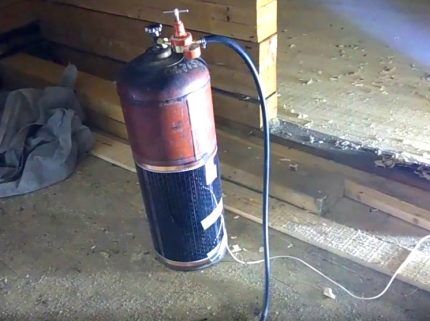
The method cannot be called the safest, because the proximity of electrical cables and a gas tank is risky under certain conditions.
But if you follow the installation rules and safety precautions, the device can be used throughout the cold season.
Method #3 - electrical devices
The principle of heating with a heating cable was taken into account, and due to the undying demand for gas cylinders, the most enterprising manufacturers began to produce electric “warmers”. They guarantee high-quality thermal insulation of cylinders and preservation of gas properties, in which it does not lose its operating functions.
There are two effective and safe devices:
- thermal blanket for a gas cylinder;
- heater.
Thermal blanket designed for heating standard 50 liter gas cylinders. It is estimated that during the cold period it allows saving up to 30% of liquefied fuel due to the fact that propane evaporation occurs stably, condensation does not fall out and refueling has to be done much less frequently.
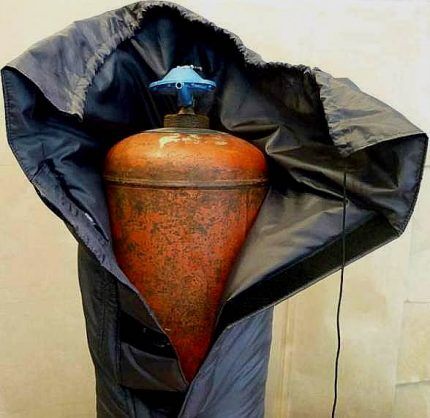
Electric blankets may vary in size. In addition to standard covers for cylinders, products are also produced for heating gas tanks. Maintained temperature – +40 °C (± 5 °C), power – about 160 W. Energy consumption is economical: at an outside air temperature of -15 °C, the blanket consumes no more than 80 W/h.
Electric heater differ from a thermal blanket in size: it does not completely cover the cylinder, but only its lower part. But the principle of operation is the same: electricity generates heat, which is constantly transferred to the body of the cylinder.

The heaters are produced for cylinders of 27 and 50 l, heating temperature is +40 °C. The degree of protection is IP 44, that is, the product can be used outdoors, provided that the cylinders are enclosed in a metal cabinet.
An alternative method is a warm room.
In order not to look for ways to insulate tanks installed on the street, you can do it easier - move the cylinders to a heated room. In comfortable conditions, the cylinders “give away” almost the entire volume of fuel, so refueling needs to be done less frequently, and there are no problems with gas movement within the supply system.
The main thing is to follow the installation and operation rules:
- the cylinder is installed vertically;
- the vessel must be accessible for maintenance, inspection or replacement;
- the distance from the tank to the stove is at least half a meter, to the radiator or stove - at least 1 m;
- if the firebox is located opposite, the distance is increased to at least 2 m.
One of the main requirements concerns the choice of room for installation.
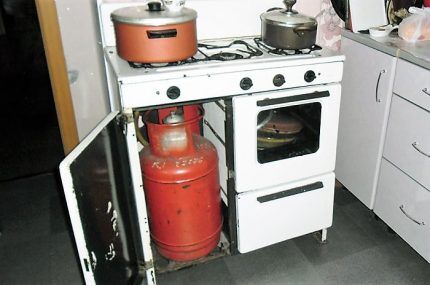
A container with liquefied gas is usually installed either directly next to the stove, or in an adjacent non-residential building, with the fuel supply hose thrown through a hole in the wall.
Cylinders must not be kept in basements, ground floors or any other premises not equipped with ventilation or a ventilation system.
And remember an important condition: if your house has more than 2 floors, placing any gas containers inside the building is prohibited!
How to warm up gas when it freezes?
Let's consider the last questions: what to do if the gas is already frozen and how is it allowed to heat a gas cylinder in winter?
If you notice that the body of blood vessels covered with frostIf the supply of fuel to the burners is difficult or has stopped completely, you can try to warm up the cylinder.
Under no circumstances should open flame sources be used - bring lighters, torches, blowtorches, burning torches, etc. to the body. As a result, an explosion may occur with unpleasant consequences.
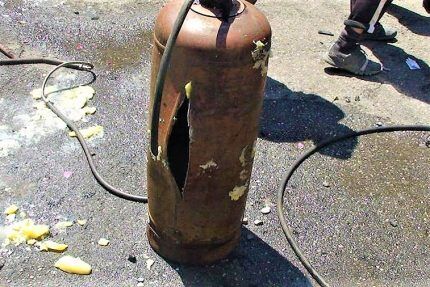
Methods that can be used for one-time, emergency heating:
- Pour hot water over the vessel or expose it to hot steam. The procedure must be performed slowly, with the valve closed. At the end you should blow gearboxto remove moisture.
- Use a chemical or salt heating pad, as is done in camping conditions. Chemical heating pads are disposable and last 6-7 hours. Salt ones are reusable, but the heating temperature is up to +50 °C, while the recommended one is +40 °C.
- Temporary transfer of the vessel to a warm room. Heating will be more effective if the cylinder is placed near the radiator for a short time.
The measures listed will not save the fuel source from subsequent freezing, but they can help out in an emergency.
Conclusions and useful video on the topic
The simplest insulation with a self-regulating cable:
An example of a homemade heater - video instructions:
Option for heating the cylinder box:
The question of whether it is possible to heat a gas cylinder on your own remains open.If you determine that the fuel supply system has stopped working due to cooling of the vessel, we recommend using safe and approved methods, taking into account all requirements.
Otherwise, you can “earn” penalties from gas service employees or, even worse, put the lives of residents in danger.
Please share your experience if you have ever heated a cylinder in winter. Leave your comments and make suggestions - the contact block is located under the article.




When a large amount of gas is taken in the gaseous fraction from the cylinder, the liquid fraction begins to boil, absorbing a large amount of heat, i.e. If we wrap the balloon in something without heating, we can make the balloon freeze even in summer.
Hence we have: for an uninterrupted supply of gas, you need to either insulate the cylinder and use heating, or increase the evaporation area by installing the gas train, for example, by 2 cylinders or more, depending on the temperature outside.
I don’t know why the site is called engineering-en.techinfus.com, but I only read speculation here and there is not a single physical explanation. — the cylinder does not heat up and therefore in the insulation it will be the same temperature as the air outside. No, it will be much colder, since it has nowhere to absorb heat. Remember one thing, cold does not exist, cold is just the absence of heat.
Last winter I dug a hole to a depth of cylinder + 30 cm.
The edges of the pit were strengthened with a steel section of a 200 liter barrel
The cylinder stood in the ground all winter, on top there was a tire and a lid from that same barrel. The gas did not freeze, but in the spring the cylinder floated from groundwater (draw your own conclusions).
I was looking for an answer on the Internet, but it looks like I’ll bury the balloon again for the winter until spring.